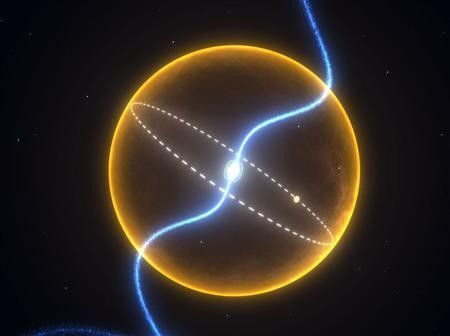First Diamond Planet Ever Discovered Orbits Pulsar 4,000 Light Years Away

An exotic planet made of diamond? Yes, that's what the astronomers at the University of Manchester claimed to have discovered in the Milky Way Galaxy.
Scientists said that the diamond-crystal planet orbits a millisecond pulsar, named PSR J1719-1438. It is located about 4,000 light years from Earth in the constellation Serpens.
To find the new carbon-based, astronomers from Australia, Germany, Italy, the UK and the U.S. used the Parkes 64-meter radio telescope in western New South Wales.
According to the study led by Professor Matthew Bailes of Swinburne University of Technology in Australia, the planet is denser than anything discovered so far, and is entirely made of carbon.
A diamond forms when carbon is put under immense pressure. Since the molecules of the planet are tightly packed together, researchers believe that it must be crystalline in nature, making it effectively a giant celestial diamond.
The evolutionary history and amazing density of the planet all suggest it is comprised of carbon -- i.e., a massive diamond orbiting a neutron star every two hours in an orbit so tight it would fit inside our own Sun, said Bailes.
It was an unusual pulsating star called pulsar, lying across some 4,000 light years away, which was first detected by the team of astronomers. Only about 12 miles in diameter, pulsars are small lifeless neutron stars that rotate hundreds of times per second and emit beams of radiation. There are 1,800 known pulsars so far, out of which only two concealed planets, and the newly discovered one is the first diamond planet ever seen.
The planet, which measures up to 55,000 km across, is about five time Earth's diameter and about 300 times heavier, as indicated by the astronomers' measurements. Scientists believe that the planet is the remnant of a once-massive star that lost its outer layers to the pulsar it used to orbit, leaving behind the crystallized core.
Researchers said the planet, which orbits its star every two hours and 10 minutes, is also likely to have oxygen as well as carbon. Because of its high density, scientists think that lighter elements like hydrogen and helium are not present in the planet.
The planet is likely to be largely carbon and oxygen, because a star made of lighter elements like hydrogen and helium would be too big to fit the measured orbiting times, said Michael Keith of CSIRO Astronomy and Space Science, and a member of the research study.
According to researchers, the planet has slightly more mass than Jupiter but is 20 times as dense Bailes and colleagues reported in the journal Science on Thursday. However, they are not sure enough about what the planet would look like up close.
It's highly speculative, but if you shine a light on it, I can't see any reason why it wouldn't sparkle like a diamond, Travis Metcalfe of the National Center for Atmospheric Research told New Scientist.
Must Read: 'Supernova of a Generation': Brightest Exploding Star in 40 Years Spotted
© Copyright IBTimes 2024. All rights reserved.






















